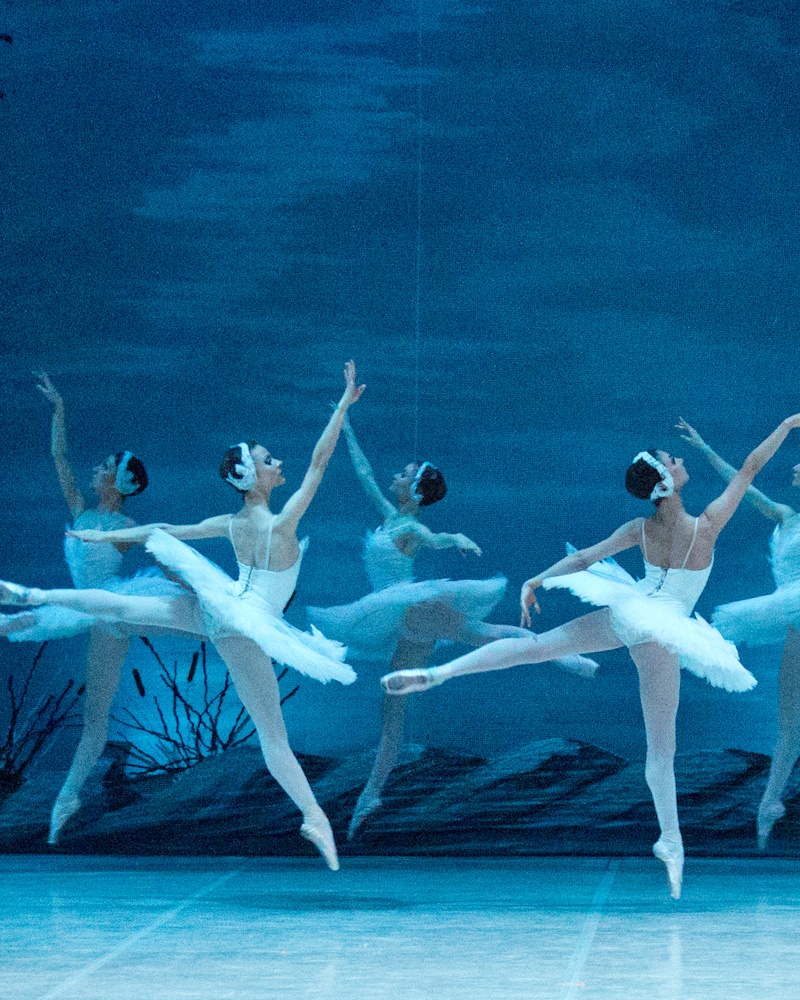Swan Lake
ballet in two acts
music by Pyotr Tchaikovsky
The history of productions of the famous ballet is full of unexpected twists and turns. “Swan Lake” firmly occupies the position of the main and sacred Russian ballet. It is impossible to imagine the repertoire of a Russian theatre without this ballet.
“Swan Lake” was first presented to the public in Moscow. The world premiere took place in 1877. We don’t know what the very first “Swan Lake” by the Czech Vaclav Reisinger looked like. Joseph Hansen, who replaced him as chief choreographer of the Bolshoi Theatre, immediately made his own version of “Swan Lake”. The performance turned out to be long-lived: it lasted on stage for ten years, with 60 performances.
But Swan Lake, as often happens in the theatre, was awakened to real life by the untimely death of Tchaikovsky. In memory of the composer, it was decided to stage his first ballet in St. Petersburg with the participation of the best artists of Russian ballet. The choreographers of the performance were Marius Petipa and Lev Ivanov. It was conducted by Riccardo Drigo, and the main role was performed by the Italian star Pierina Legnani.
It was Ivanov and Petipa who saw something more in “Swan Lake” than the official fairy tale with which the repertoire of the Imperial Theatres was flooded. Despite the confrontation with the public and the press, these masters raised the professional level of choreography and put their art on par with the century. Their “Swan Lake,” which appeared in the mid-1890s, was created using classical means, but is in tune with the main themes of modernism — the theme of authenticity and imaginary, the dark side of beauty, overcoming temptations and loyalty to dreams.
After Ivanov and Petipa, who did not escape their share of comments, both from Tchaikovsky’s admirers and from the guardians of ballet canons, the initiative for a deeper reading of Swan Lake passed to Moscow. However it was brought to the Bolshoi Theatre by a St. Petersburger, Petipa’s student, Alexander Gorsky. He fled to Moscow, which back then was usually considered a provincial exile, in order to get the right to experiment away from the teacher. It was precisely thanks to Gorsky’s quarter-century of activity that the Bolshoi Theatre regained its independent artistic identity. At a time when Russian ballet flocked en masse to Paris and London under the banner of Diaghilev, Gorsky conducted incredible experiments in Moscow that brought his searches closer to the activities of the young and energetic Art Theatre. At the very beginning of his career, in 1901, the choreographer reproduced the performance of Ivanov and Petipa at the Bolshoi Theatre, which remained in the repertoire for 18 years and was shown 116 times. However, the turning point in the fate of Swan Lake was Gorsky’s decision to involve Vladimir Nemirovich-Danchenko as the director of the play, who helped him turn the ballet into a choreodrama. This version lasted only five performances, but, ahead of its time, laid the foundation for a new direction in ballet, which triumphed in the middle of the twentieth century.
Alexander Gorsky created a new edition of the play, abandoning the most radical techniques, and it had a long and successful run at the Bolshoi Theatre.
Traces of Gorsky’s production can still be found today in the St. Petersburg version of “Swan Lake”. The same production became the basis for the legendary production by Asaf Messerer and Evgenia Dolinskaya. This version lasted on the Moscow stage until 1975. Marina Semenova and Galina Ulanova, Maya Plisetskaya and Raisa Struchkova shone in it, as well as Western ballerinas, including a British ballet dancer Beryl Gray.
However, the real record holder turned out to be Yuri Grigorovich — his “Swan Lake” has been running since 1969. The second, “swan” scene in it was preserved in the choreography of Lev Ivanov, the pas de trois of the first scene and the dance of the Great Swans are a tribute to Gorsky’s skill, but the choreographer found new themes in the ancient ballet. He believed the prince to be the main character of the drama, and not the girl enchanted into a swan. It is in the soul of Siegfried, who is the embodiment of knightly valour, that the battle of good and evil, light and dark principles, symbolized by the Evil Genius, takes place. This production, repeatedly edited by Grigorovich himself, became a new word in ballet. Now it is recognized as a classic.
Libretto after Vladimir Begichev and Vasily Geltzer
- ChoreographyMarius Petipa, Lev Ivanov, Alexander Gorsky, Viacheslav Gordeev
- Revival of the balletEkaterina Aksenova
- Stage DesignerIgor Nezniy
- Costume DesignerTatiana Tulubieva



